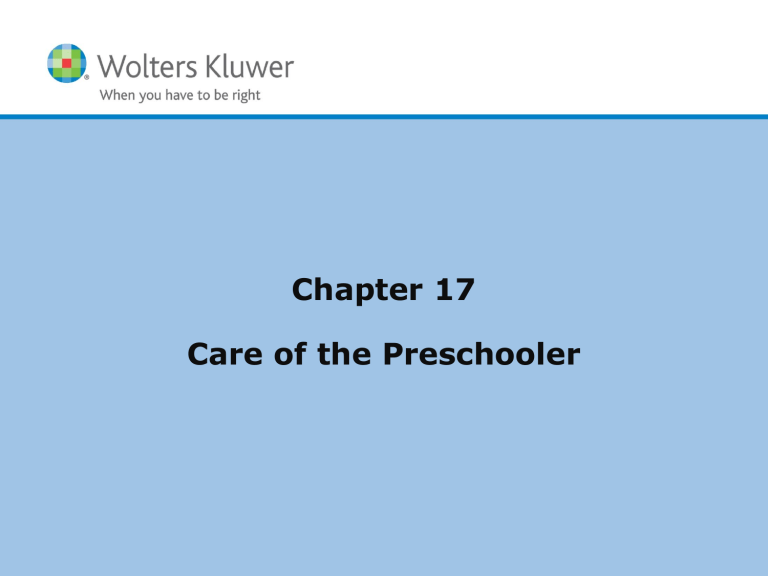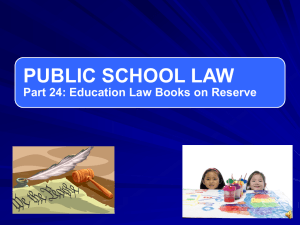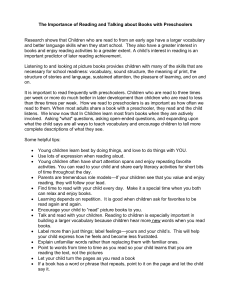
Chapter 17 Care of the Preschooler Copyright © 2014 Wolters Kluwer Health | Lippincott Williams & Wilkins Preschool Stage From 3 to 6 years of age. Gross motor skills become more coordinated. Fine motor skills develop exponentially. Preschoolers take initiative and try new things. Imagination and creativity are key. Copyright © 2020 Wolters Kluwer · All Rights Reserved Health Assessment of Preschoolers Begin to involve child in health history. Allow the choice of sitting on the examination table or in the parent’s lap. Give choices throughout examination. Allow the preschooler to play with safe medical equipment. Perform most invasive parts last. Implement visual acuity testing at age 4. Assess hearing with optoacoustic emissions test. To inspect the pinna of the ear at age 3, pull it up and back. Can incorporate more formal assessments and screenings. Play games to illicit cooperation. Can use radial pulses for heart rate assessments. Copyright © 2020 Wolters Kluwer · All Rights Reserved Physical Variants in Preschoolers Visual acuity reaches 20/20 at 4 to 5 years of age. Thoracic breathing begins at age 5. May experience stool holding during toilet training. Full daytime bladder control around 3 years of age. Nighttime bladder control around 4 to 5 years of age. Genu valgum (knock-knees) in early preschool period. Body is more slender and abdominal muscles are stronger. Copyright © 2020 Wolters Kluwer · All Rights Reserved Pain Assessment of Preschoolers Are able to point to location of pain. Not able to describe the quality of pain. Able to use developmentally-appropriate self-report tools. Oucher scale: o Six points with corresponding photos of children’s faces depicting different levels of pain. o Scale of 0 to 100, with higher number indicating more pain. FACES scale: o Six cartoon faces with different expressions. o Scale of 0 to 10, with higher number indicating more pain. Also use observation and caregiver report to assess pain. Copyright © 2020 Wolters Kluwer · All Rights Reserved Physical Growth of Preschoolers Height: o Grow 2.5 to 3 in (6.1 to 7.6 cm) per year. o Average 4 year old height is 40 in (3.3 ft). Weight: o Gain 5 lb (2.3 kg) per year from ages 3 to 6. o Average 4 year old weighs 40 lb (18.1 kg). Head circumference: o Brain growth slows. o Only 1.9 to 2.4 in (5 to 6 cm) increase from 3 to 18 years of age. Document all physical growth data points on growth charts to assess trends and averages. Copyright © 2020 Wolters Kluwer · All Rights Reserved Developmental Theories #1 Psychosocial: o Erikson stage of initiative vs. guilt. o Asserts self more and wants to please parents. o Plans and initiates activities. Cognitive: o Preoperational stage until 4 years of age. o Remains egocentric and focuses only on one aspect. o Transductive reasoning: connecting unrelated events. o Intuitive thinking after 4 years of age. o Develops logical thought based on perception. o Irreversibility: unable to reverse sequence of events. o Magical thinking: fantasy and vivid imaginations. Copyright © 2020 Wolters Kluwer · All Rights Reserved Developmental Theories #2 Moral: o Preconventional stage. o Right and wrong is interpreted through punishment and reward. o Rules are seen as absolute. Psychosexual: o Phallic stage. o Genitals become area of interest. o Identifies more with parents of the same sex. Copyright © 2020 Wolters Kluwer · All Rights Reserved Gross Motor Development of Preschoolers Copyright © 2020 Wolters Kluwer · All Rights Reserved Fine Motor Development of Preschoolers Copyright © 2020 Wolters Kluwer · All Rights Reserved Communication and Speech of Preschoolers #1 Rapid language acquisition. Uses concrete language. Children living in poverty are at increased risk of language delay. Language is learned through exposure to words. Screen for language delays at each well-child visit. Underlying causes of language delay include: o Autism o Cognitive impairment o Emotional delays o Low socioeconomic status or neglect o Underlying neurological disorders Copyright © 2020 Wolters Kluwer · All Rights Reserved Communication and Speech of Preschoolers #2 Copyright © 2020 Wolters Kluwer · All Rights Reserved Social and Emotional Development #1 Learn to cope with emotions. Use imaginary play and imaginary friends to explore communication and emotions. Interested in basic sexuality by the age of 5 to 6. Develop their own identity and independence. Cooperation is more common. Learn to share and take turns. Copyright © 2020 Wolters Kluwer · All Rights Reserved Social and Emotional Development #2 Copyright © 2020 Wolters Kluwer · All Rights Reserved Safety Considerations for Preschoolers Like new experiences. Don’t comprehend risks. Role model safe behaviors. Stranger safety and street safety are most important. Teach home address and phone number. Natural curiosity can create harmful situations such as: o Improper handling of firearms o Poisoning o Choking Copyright © 2020 Wolters Kluwer · All Rights Reserved School Readiness Read to children: o Use picture books. o Books with a few words per page. Carry on conversations: o Ask open-ended questions. Provide structured environments with choices. Encourage social interactions with peers. Implement Head Start or other preschool services for low-income families. Copyright © 2020 Wolters Kluwer · All Rights Reserved Play Considerations for Preschoolers Engage in imaginary and creative play. Allow to work through frustration and anxiety. Use arts and crafts for fine motor skills such as: o Modeling clay o Crayons Learn to share and take turns: o Simple board games Outdoor activities: o Playgrounds, bicycles, tricycles o Unstructured physical activity Toys to avoid: o Toys with small parts, small magnets, or lead paint. o Excessive electronics. Copyright © 2020 Wolters Kluwer · All Rights Reserved Sleep Considerations for Preschoolers Hours of sleep are consolidated into one long block. Require 10 to 13 hours per day of sleep. Naps typically end around 4 years of age. Establish bedtime routines and remain consistent. Nightmares: o Child wakes up scared and wants comfort from parents. o Talk about nightmare and assist the child back to sleep. Night terrors: o Child is not awake when they occur and does not remember episodes. o May scream, kick, thrash, or push parents away. o Do not try to wake the child. Copyright © 2020 Wolters Kluwer · All Rights Reserved Discipline for Preschoolers Preschoolers behave better if given opportunities for independence with set limits. Incorporate daily routines for consistency. Explain consequences for rule-breaking. Time-outs: o Used to remove child from environment. o 1 min per year of age. Avoid yelling and spanking: o Leads to aggression and physical struggles. Copyright © 2020 Wolters Kluwer · All Rights Reserved Nutrition for Preschoolers Focus on a healthy, well-rounded diet. Incorporate fruits, vegetables, whole grains, and lean proteins. Requires 1,200 to 1,400 calories per day. Avoid foods high in fat and sugar. Three meals and one to two snacks per day. Involve child in meal preparation and offer choices when possible. Do not fix separate meals; this encourages picky eating. Do not force intake if child is not hungry. Copyright © 2020 Wolters Kluwer · All Rights Reserved Lying Stems from overactive imaginations or to avoid punishment. Reasons for lying change as preschoolers get older. Teach children that lying is never okay. Role model positive behaviors. Punishment should be based on severity of the transgression and lie. Praise preschoolers for telling the truth. Copyright © 2020 Wolters Kluwer · All Rights Reserved Fifth Disease Also known as erythema infectiosum. Caused by parvovirus B19. Peaks in late winter and spring. Bright red cheeks with “slapped” appearance. Lacy rash on trunk and upper extremities. Benign and self-limiting. Offer supportive treatment if prodromal symptoms. Avoid pregnant women because virus can harm fetus. Copyright © 2020 Wolters Kluwer · All Rights Reserved Hand-Foot-and-Mouth Disease Caused by coxsackie virus. Spread through fecal-oral route. Prevented with proper hand washing. Vesicular and/or pustular lesions occur on the oropharynx, palms of hands, and soles of feet. May have mild fever and moderate pain. Self-limiting condition; usually resolves after 1 week. Supportive care for symptomatic management. Monitor for dehydration. Copyright © 2020 Wolters Kluwer · All Rights Reserved Conjunctivitis Inflammation of conjunctiva. Also known as “pink-eye.” Can be bacterial, viral, or allergic. Typically associated with thick drainage, pruritus, and/or vision changes. Very contagious. Treat based on cause (antibiotics, symptomatic management, antihistamines). Viral is self-limiting. Copyright © 2020 Wolters Kluwer · All Rights Reserved






